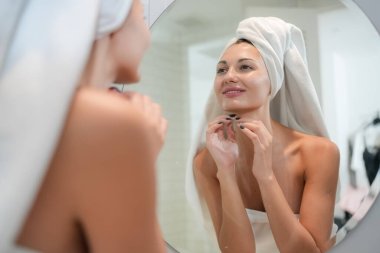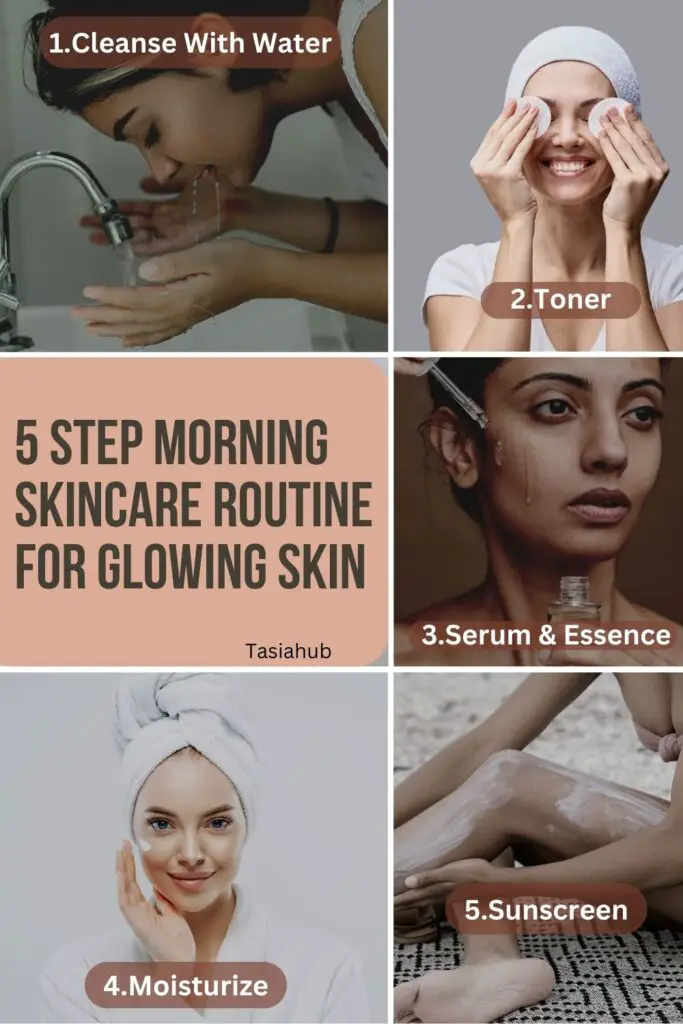Basic 5-Step Morning Skincare Routine For Glowing Skin

The Top 5 Morning Skincare Routine Order for the Perfect Complexion
Achieving the perfect complexion takes more than just washing your face and using a moisturizer. In order to get the most out of your skincare, it’s important to create a routine that targets your specific needs. Here are the basic 5 steps in a skincare routine for the perfect complexion!
A Good Rule Of Thumb: Skincare products should be applied from the lightest to the heaviest.

What Are The 5 Steps In A Skincare Routine?
Step 1: Cleansing With Water
If you properly clean makeup and dirt on your face during your nighttime skincare routine, it’s best to just wash your face with water in the morning.
This gives your skin time to repair itself, think about it, you apply all your skincare products at night and go to sleep for your skin to repair itself, your skin is not exposed to environmental pollution, dirt, or oil while you sleep, so there’s really no need for you to use your face wash or cleanser in the morning.
Additionally, cleansing your face in the morning with a cleanser or face wash removes all the good stuff you’ve put on your face the previous night. Cleansers are designed to remove dirt, oil, and grime, so using one in the morning will remove all the goodness of the serum and moisturizers you apply in the night.
However, there are those who should always use a cleanser or face wash in the morning; people with highly acne-prone skin and people with excessive oil should use a cleanser in the morning to help kill bacteria and remove excess oil.
Step 2: Toners Or Astringents
Face toners are usually water-based solutions used after cleansing your face to restore moisture to the skin. Astringents are water-based formulations used to remove excess oil from the skin, tighten pores, and remove makeup left over.
Astringents are more effective for oily skin and acne-prone skin because they tighten the skin and clear clogged pores. While astringents are perfect for oily skin and acne-prone skin, toners are perfect for dry and normal skin.
Whether you’re doing a morning or nighttime skincare routine, it’s important to follow up with a good hydrating toner or astringent after cleansing.
Face toners prep the skin for your serum and moisturizer by getting rid of excess oil, makeup leftovers, and stubborn dirt on the skin after cleansing.
There are several varieties of toners out there for different skin concerns, there are toners for oily skin, acne-prone skin, dry skin, and sensitive skin, there are also antiaging toners for those battling with wrinkles, so get a toner that targets your skin concern.
For example:
- A toner containing salicylic and glycolic acid is great for oily skin because it can help keep your skin dry all day.
- A toner containing rose water is great for dry skin.
- A toner containing tea tree oil fights oil and bacteria on the skin.
- A toner containing vitamin E is great for hydration.
- A toner containing chamomile soothes the skin.
- A toner containing aloe vera is great for inflammation and redness.
Astringents include:
- Citric acid
- Salicylic acid.
- Witch hazel.
- Alcohol.
For best results, use toner twice daily but if your skin gets easily irritated or dry, it’s best to use toner once a day or every other day. Astringents are used once a day, preferably in the night.
For toners formulated with more astringents which are designed for oily and acne-prone skin, it’s best to use it every two days, gradually building your way up to using it every day.
Step 3: Essence And Serums
By now your face totally clean and ready to take in any other product, well done! Now it’s time to apply essence and serum to give your skin an extra boost and hydration.
Serums are light-weight skincare product that contains a higher concentration of active ingredients such as glycolic acid, hyaluronic acid, and vitamin C.
Serums are known to manage specific skin concerns such as wrinkles, dry skin, acne, and dullness, they are designed to brighten, hydrate, and treat certain skin conditions depending on the type of serum you use. Serums can come in different formulas, including gel, oil, and water-based consistency.
Essence hydrates the skin, reduces the appearance of wrinkles, protects the skin barrier, balances the pH level of the skin, and boosts the health of the skin, when essence is applied before serums, it helps the skin better absorb the nutrients from the serum, that doesn’t mean you can’t apply serums without essence, but applying essence before serum is like icing on the cake.
Always remember to buy serums and essences suitable for your skin type.
Give your skin time and space to absorb any product you’ve applied before moving to the next one, give it at least a minute to absorb each product.
Step 4: Moisturizers
After essence and serum, move to moisturizers, moisturizers are a key part of any skincare routine. They help keep skin hydrated, which can help keep skin looking healthy and youthful.
There are different types of moisturizers available, so it can be tricky to find the right one for your skin type.
When choosing a moisturizer, you should consider your skin type and the climate you live in. If you have oily skin, you may want to choose a light, oil-free moisturizer.
If you have dry skin, you may want to choose a moisturizer that contains hydrating ingredients, such as glycerin or shea butter. If you live in a climate with dry air, you may need to use a heavier moisturizer to keep your skin hydrated.
It’s also important to choose a moisturizer that is free of fragrances and other harsh chemicals. Fragrances can be irritating to the skin, and harsh chemicals can cause skin to become dry and irritated.
When using a moisturizer, be sure to apply it to your entire face, including your forehead, cheeks, nose, and chin. Gently massage the moisturizer into your skin until it is fully absorbed. Repeat this process every morning and evening.
Step 5: SPF
A sunscreen with an SPF of 15 will filter out 95% of the sun’s UVB, and an SPF of 30 will filter out approximately 97% of the sun’s UVB radiation.
Sunscreens with higher SPFs filter out more of the sun’s radiation, a sunscreen with an SPF of 50 will filter out approximately 98% of the sun’s UVB radiation. Sunscreens with an SPF of 100 will filter out approximately 99% of the sun’s UVB radiation.
Constantly skipping sunscreen in your everyday routine can lead to premature aging, wrinkles, fine lines, and skin discoloration. If you constantly get sunburns over a number of years, you might be increasing your chances of developing skin cancer.
Conclusion
By following these 5 steps skincare routine, you’ll be on your way to achieving a beautiful and healthy complexion. Remember to customize your routine to fit your individual needs, and be patient – results may take time to appear!
